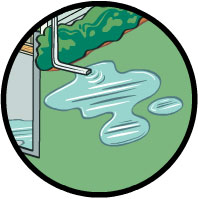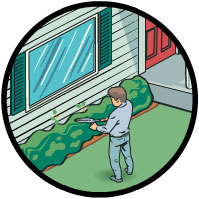 Drainage
Drainage
A Dry Idea: Use splash blocks beneath downspouts to move water away from your house. These concrete blocks are readily available at most hardware stores.
-
Without proper drainage moving water away from the foundation, water can seep into your basement or crawlspace and create a number of problems. Check that the perimeter ground slopes away from the foundation.
-
Inspect the outdoor deck connection to the house. This is major source of water intrusion that often goes unnoticed. This connection should be flashed and have sufficient space between the ledger board and the deck boards to allow drainage away from the house.
-
Call a landscaper or a weatherproofing firm if you can't figure out how to move water away from your house. One of the keys to drainage is having soil that doesn't absorb moisture. If the soil around the foundation is expansive (a clay that absorbs moisture), replace it with backfill material consisting of soils or gravels that do not expand when wet.
-
Inspect drainage during a heavy rain to observe the water path from the house.
 Sprinklers
Sprinklers
Drip Alert: Moisture problems can also stem from pressure-washing your house. If you decide to use a pressure-washer, be sure that you never direct the stream of water up under your siding. This can trap the moisture between your siding and walls and create problems.
-
Position sprinklers to water your yard, not your house. Make sure lawn sprinklers aren't consistently wetting the siding, windows, or foundation walls.
-
Overwatering your lawn or plants can create moisture and mold problems even in the summer.
 Landscaping
Landscaping
A Dry Idea: Approach your plan for moisture-free landscaping as you would approach painting your house. If you would have to cut a plant to paint your siding, it is too close to your house and could lead to moisture problems. Keep this in mind as you examine your landscaping, and formulate plans for future improvements considering the growth of your plants in relation to your house.
-
Trim plant life away from the siding. Large shrubs may need to be removed if foliage persistently contacts siding, windows, or utility penetrations like dryer vents.
-
Tree roots can interfere with perimeter footing drain systems, disrupting the flow of water away from the house and causing dampness or flooding along the foundation and into the basement. Design your landscaping to minimize potential root blockage of underground pipes.
-
Do not use invasive ground covers like English ivy as foundation plantings.
-
Maintain at least 6 in. clearance from the bottom of the siding to the ground.